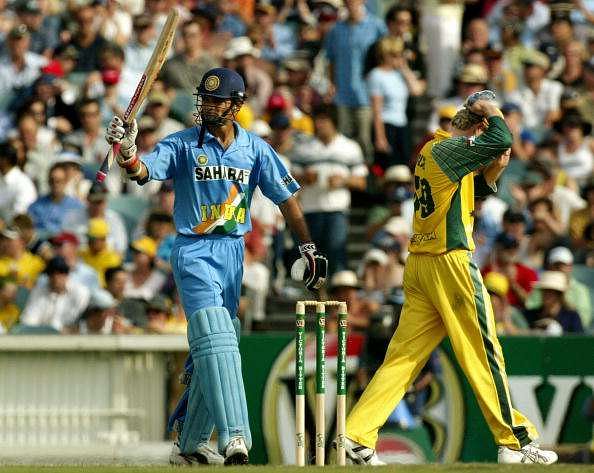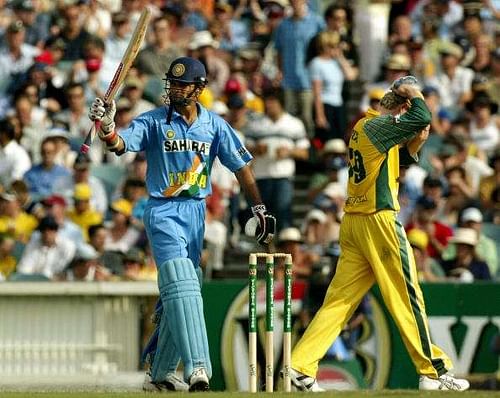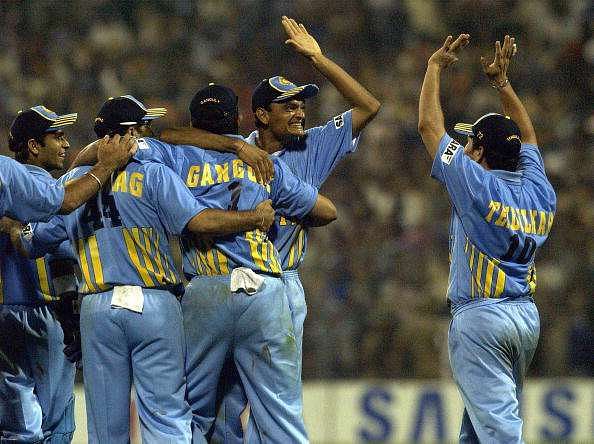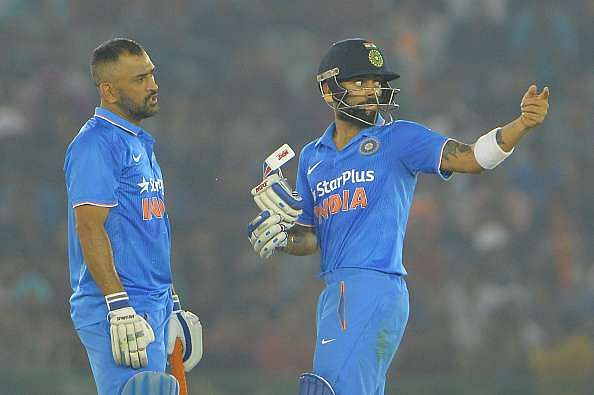
Interview: Hemang Badani on Virat Kohli - "There isn't anyone else who should lead the national side"
Sandwiched between the primal batting kings at the top and the slot-filling, bat-clenching bunglers at the bottom, lie the glue of the team - the middle-order batsman. Often thrown into a cauldron of complex mathematical equations and jittery death-overs, they are handed the perplexing job of finishing off a limited-overs match.
What exactly is the magic formula?
“I always believe you should take it to the last,” says Hemang Badani. A combative left-handed batsman with a penchant to play straight down the ground, Badani was one of the vital components of a resurgent Indian team, boasting a batting average of over 50 in the initial part of his career. His level-headed batting in the final overs helped the Indian side clinch some real cliffhangers in the early 2000s, way before the likes of Yuvraj Singh and MS Dhoni made the art of finishing games glamorous with their thunderous bat-swings.
“I had talks with Michael Bevan, who was the best finisher in my era. There is no need to press the panic button. With wickets in hand, 6-7 runs in an over was very gettable in that era - you just needed one boundary every over or a six in every two overs”.
For Badani, the ascent to the Indian team was hardly meteoric. It was a gradual process, an unwavering display of grit and determination that cemented his spot in the XI as he progressed upwards, level after level.
His father, who played lower-divisional cricket in Madras (Chennai), sensed talent in him when he was just nine.
“My dad used to play club cricket, and as a toddler, I’d go along just to watch him play. It was like a picnic. One day, he didn't have enough guys to play a game. He thought maybe I could come in and field: worst case scenario - I’d miss out a few balls. That way he could make eleven players on the field as well. At that time, there was a possibility to draw the game. At that stage, my dad and I batted for two hours and I remained not out on three. I had no cricket kit, I was wearing my uncle’s pads, with everything being three times my size. I had as many as seven close-in fielders around me.”
Today, he is surprised by the way youngsters are being pushed into the game way too early by over-enthusiastic parents. Recently, one of his friends asked him about enrolling his seven-year-old kid for coaching.
“Seven years is too early for them. They don’t understand the game then, they just want to hit the ball. At that age, the game is too structured for them. Kids are too small to understand concepts like technique and survival. Let them enjoy the game.”
As was true for a whole generation of players in his era, Badani developed a fascination for the game after India’s 1983 World Cup triumph. When Kapil Dev lifted the Prudential silverware at Lord’s on 25th June, a seven-year-old in Tamil Nadu was inspired to make his own name.
“I just took up the sport after the 1983 World Cup. After the win, it triggered a feeling that even I could go on to be somebody. However, actual seriousness to pursue the sport happened much later.”
As he went on to play the game at a competitive level, others saw potential in him to perform. He concedes that he wasn’t the ‘next big kid’, but he was earmarked to do well for the state team, if given a chance. Interestingly, he started off as a medium-pacer who could bat a bit.
“I was always told to be a kid with decent potential, even as I rose up the ranks at the U-12, U-15, U-17 and U-19 levels. I kept scoring the odd 100, 150s, but I was not breaking any doors.”
When things weren’t looking bright, he had a chat with his father, who wanted him to re-assess his future. Since he belonged to a business background, he always had something to fall back on. That served as a pep-talk to him. He concedes that it was the “turning point of my life.”
“I decided to give myself one more year. I put in the hard yards that year: I concentrated on how I trained and what I ate. I wasn’t the typical 19-year old partying. I watched my sleep as well. I decided to give it my best.”
The testing period bore rich dividends, as Badani clinched a spot in the Indian U-19 team for a series against South Africa, a tournament where he ended up being the highest run-getter overall.
“That side comprised the likes of Mark Boucher, Makhaya Ntini, Boeta Dippenaar and Nantie Hayward, to name a handful. But we were all 19-year olds, we didn’t know who’s gonna turn out to be whom.”
“I was then selected to play ODIs for Tamil Nadu, where I scored a 75 not out on debut. During those days, ODIs were followed by the four-day games. Initially, I was not slated to play the longer format. But looking at my form, I was retained for the four-day matches as well.”
What followed was a dream phase for Badani, getting big scores and breaking into the India-A team. From having serious doubts twelve months ago, he had evolved into a batsman on the fringes of national selection.
Yet, he had a poor year after his Ranji Trophy debut. He had to go back to the queue, and score runs again for the next three-four years before the big break came.
The hard work wasn’t to go waste, as he got selected to be part of the Indian team for the Asia Cup in May 2000. It was at a time when the team was reeling under the impact of the match-fixing saga, with several experienced players having been ousted from the first XI.
“It was actually a good period because lots of youngsters got in, many with whom I had played cricket over the years. There were four-five seniors, players with whom you could gel and talk.”
“I made my debut against Bangladesh in Dhaka, May 2000. Before that, we had a camp in Pune. To my luck or bad fortune, I was sitting next to Sachin Tendulkar in the dressing room. I was really nervous, as I didn’t know if I could talk to him or not, or will he talk to me.”
Apart from Sachin, the side had the likes of Rahul Dravid, VVS Laxman and Anil Kumble, all of whom were from the South of India, and had played the game with Badani at various levels. With “Lacchi” VVS Laxman, Badani shared a special connect. The two had been playing together ever since the state U-12s.
“They had seen me grow. I used to nag them with questions, and there was a really good connect. They are genuinely nice and easily going people who are open to chat. They know what works at the highest level, and what changes need to be incorporated. You had a guy like Dravid to counsel you, and then a strong guy like Ganguly to have in the team as well.”
A major highlight of his career was a 98-ball ton against the mighty Australians, one of the most dominating sides to have played the game in the modern era. With the likes of Ricky Ponting, Glenn McGrath, the Waugh brothers and Brett Lee, to name a few, the side was a juggernaut that refused to halt.
“I don’t think they can ever get a team like that, winning 16 Tests on the trot, winning consecutive World Cups. The current teams can be good, but not as good as those in the glory days. They knew clearly what they had to do on the field. They had some 7-8 players who could win the match on their own skills.
For a 24-year old, a century in only his tenth ODI served as a major morale-booster. Yet, with great fame, come great responsibilities. It is imperative for a youngster to stay in the present.
“It is obvious for a player to think a little ahead of himself, but you need to start focussing on your game. Sometimes you overlook the small things like watching the ball and moving your feet. There are times when you are not in the present. Lots of players go through this phase, I went through it too.”
“Sometimes, it’s just about how the individual is handling pressure on that given day. Somebody can hit the ball, but the question is, can he do it then. I have seen people who have were far better than me at the domestic circuit, but didn’t have the courage or character to go to the next level.”
Things are different now. With T20s ruling the roost, several domestic leagues have cropped up all over the place. There is ample scope for a youngster to prove his mettle, a flash-in-the-pan effort can also garner instant recognition.
“T20s are the way forward now. I would have been more than happy to have this sort of a system during my time. There might be around 20 players who had a good IPL season and straight away got picked for the national side. We had to play the entire Ranji trophy and side games for three to four years, putting runs on the board with the hope that something would click.”
With TV coverage and social media interaction forming an integral part of the T20 game, even at the lower levels, there is so much more visibility for upcoming players to showcase their talent on a larger scale. The Tamil Nadu Premier League and the Karnataka Premier League have been two such tournaments that have been instrumental in unearthing some of the best young talents.
“N. Jagadeesan was the leading run-getter in the TNPL this year. He got selected for the Tamil Nadu side, got to play and scored a century on debut. He has a sound technique and character, and he has handled himself pretty well. That is what TNPL is all about.”
“During our time, a guy in Karnataka had no idea how someone in a Jammu & Kashmir or a Haryana was performing. Probably, you would have read the scores in the papers. But you would never have seen him play.”
“Now, if a player doesn’t get picked, there is so much talk on Facebook, with people discussing the player’s exclusion. It gives the selectors the added responsibility of choosing the best players. One good season of T20 and you’re straightaway picked.”
When the T20s did hit the jackpot in 2007, Hemang Badani had already crossed 30 and took a realistic call of his chances as an international cricketer. During that time, the Indian Cricket League (ICL) also came calling.
“There was no point to just hang around. I saw so many seniors hang around for no rhyme or reason, ensuring that the youngsters didn’t play. If you are not contributing, you should just step aside.”
“I had a talk with the national selectors, and this was at a time when the likes of Suresh Raina and Venugopal Rao were coming in. The selectors conceded that I was a good player and that I had done well in whatever limited opportunities I had got. However, they were looking at a younger batch then. They had a plan going forward, which was correct for them.”
“I realised that enough is enough. I chose the ICL with the intention of playing three years of good cricket at the highest level, rubbing shoulders with the best in the world, and then retire.”
Badani played domestic cricket till 2012, handling the dual role of being one of the batting powerhouses of the sides he represented, and being a father figure to a whole generation of youngsters who were finding their feet at that level. He counseled multiple newbies, passing valuable tips about performing at the top level and handling pressure.
“At a point, you’ll have to start mentoring. When I came back from the ICL, I didn’t want to be just a batsman in the team, when I could offer a lot to the younger ones. It is all about teaching them to handle pressure: there are a lot of good players who fail because of lack of faith and self-confidence. Helping them out gave me more satisfaction than scoring runs.”
After being associated with Tamil Nadu for 13 years, he moved to Rajasthan, leaving behind him a set-side that comprised of players like Subramanium Badrinath, Murali Vijay, Ravichandran Ashwin, Lakshmipathy Balaji, Dinesh Karthik and Abhinav Mukund. He later went on to play for Haryana, before moving to Vidarbha for the final part of his playing career.
The 39-year old has been quite actively involved with cricket, even after hanging up his boots. A keen follower of the game, he has been tracking India’s clinical performances across all three formats. While the world goes gaga over Ravi Ashwin’s sensational bowling form, Badani’s mind goes back to the time when the 30-year old was a youngster who had just broken into the Tamil Nadu Ranji team.
“I have seen him grow. My last year of cricket in TN was when Ashwin came into the side. He was not a big turner of the ball but he was a very sharp guy, always asking questions, always wanting to find out what should be done. He’d have odd fields and ideas that weren’t normal. He’s just got better with time.”
As for Ashwin’s Test captain, Virat Kohli, Badani has the highest praise, terming him the best guy to lead the side at the moment. Having interacted with MS Dhoni as well, Badani gives a clear understanding about the captaincy styles of the two pillars of Indian cricket, both of whom are as emotionally different from each other as chalk and cheese.
“Kohli’s a guy who’s passionate to the core and loves finishing games. Most importantly, he loves winning. That is the simplest trait I look for in a captain. I don’t believe in the saying that you are a born captain, it is just a term you and me use. Great captains have attributes like passion, deliverance and being on the field and backing the players, no matter what.”
“Kohli has the same passion as Dhoni. MS was a lot more calmer, he doesn’t show it on the field. He built players and gives them confidence, taking all the pressure on himself. In a way, Kohli does the same thing. One is vociferous, in-your-face; the other one is a lot more subtle and hardly emotional, he has the same passion and has done yeoman service to the nation”.
Also read: Ravichandran Ashwin says Virat Kohli will take Indian cricket to greater heights
Earlier this year, Badani was the coach of Virgo Super Kings, one of the teams in the Masters Champions League that had players like Graeme Smith, Brett Lee and Jonty Rhodes in its ranks. Despite having played his last Ranji game three years ago, his passion for the game hasn’t waned.
“Currently, I am involved in coaching and commentary. As we speak, I am looking to hold an U-14 tournament for kids in Tamil Nadu, in association with a bank. I help out at an academy in UK, assisting them in their programs and schedules. The love of the sport just keeps me going.”
Doesn’t he sometimes feel like padding up and walking off to the middle?
“I was just talking to someone recently, I am itching to hold a bat and getting to the middle. It’s been a long time. One of these days, I might just go and play.”
Last year, his first-division side was on the cusp of getting relegated after a poor showing with the bat. It was Badani who turned out to be the saviour, padding up after a hiatus of one and a half years to pull the plug on the collapse. He batted for close to three hours on a tough wicket, hauling his struggling side to safety.
“It was fun to get bat on ball. But it wasn’t fun later on in the evening, with my body aching. It was terrible for three days!”
With coaching and commentating keeping him busy, it’s fair to say that there’s plenty of cricket left in Hemang Badani. An international cricketer looking to get his hands dirty for the game’s betterment at the grassroots level is just what the sport is in need of today. And when someone as eloquent as Badani steps up, it’s a delight for both the fans of the game and the kids that turn up at camps.
As a Guest Columnist, Hemang Badani will be writing periodic cricket columns for Sportskeeda Cricket.


